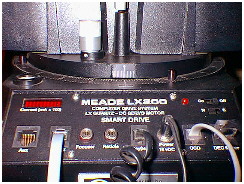Calibrating the LX200 Drives

Calibrating the drives is very critical to the guiding feature of the ST7. The need for calibrating the drives is to let the software know how long to pulse the drives to place a star's centroid back to its original position on the chip.
The calibration procedure exercises the RA and DEC drives in both directions (ie: -x and +x then -y and +y). Before calibrating the drives, be sure the camera is aligned with the forks as described in the previous 'Setup' page. Place the telescope at 0 degrees declination close to your meridian. (Meridian is the line drwn from North to South directly above you). Select 'calibration' in the track menu and enter 3 seconds in the exposure time dialog box, enter '2' for the 'x' parameter and '3' for the 'y' parameter.
After entering the parameters in the calibration dialog box, hit 'enter'. The camera will then automatically find the brightest star in the field of view, measure its centroid brightness and display its postion on the chip and its brightness level. The calibration star's peak value should be more than 1000. The software will then pulse the telescope drive, take another 3 second exposure and measure the stars new postion on the chip (new ' x' postion). It will again pulse the telesope back and take another 3 second exposure attempting to place the star image back to its original postion on the chip. It will then repeat the procedure for the DEC drive. A typical calibration sequence should be similar to the one in the table below.
Sample Drive Calibration Results
| 'x' postion on chip | 'y' position on chip | Brightness |
| 296 | 143 | 3289 |
| 281 | 143 | 2994 |
| 295 | 143 | 3093 |
| 295 | 132 | 3099 |
| 295 | 143 | 2956 |
If the calibration procedure does not see at least a 4 pixel move in any one of the drive exercises, it will warn you of the failure. Increase the number of the axis that failed. Example: if the 'y' axis calibration did not see any movement in the drive try increasing the move time to 4 or even 5. Movements of at least 4 to as many as 100 pixels are recommended. I personally try for around 20.
Still Having Problems???
1. Try selecting the 'tracking chip' in the calibration parameters box.
2. Again, try increasing the move time for the offending drive.
3. If you suspect a sloppy drive (high backlash) have the calibration make 2 or even 3 steps in each drive move. (This parameter is in the calibration parameter box). With this parameter set to 1 the calibration will make 1 move in 1 direction. If you select 2, it will move in 2 steps in 1 direction etc.. (See owners manual for more documentation).
4. Make sure drives are operating. Try moving telescope in RA and DEC to assure the drives are working.
5. Re-check the balance of the telescope especially if the 'y' calibration contiues to fail.
6. Re-check the DEC 'backlash parameters' for the LX200 if the 'y' axis calibration continues to fail.
7. If the x and/or y positions jump dramatically it is usually because a star with the same or brighter magnitude has entered the chip's field of view. Pulse the telescope in either RA or DEC to find another calibration star.
After the drives are calibrated, it's time to aquire an image while self guiding.
Back to main menu.

